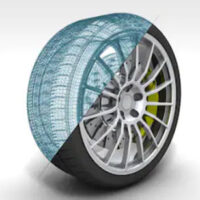Let’s Talk Tire Safety

Maintaining your tires is the single most important thing you can do to ensure the safety of your car, truck, or SUV – and by extension, your life and those of your passengers. This article will show you how important one of the simplest parts of a vehicle (well, four of them, to be exact) truly is every single time you get behind the wheel.
If you run out of gas, the car will eventually sputter and stop. If an engine isn’t properly maintained, chances are the car will one day refuse to start. These are serious and potentially expensive problems, but the general rule is that neither of these scenarios will cause a catastrophe on the road – if your vehicle even gets going in the first place.
Why Is Tire Pressure Important?
Driving on tires that aren’t properly inflated could lead to sudden and catastrophic tire failure. Ironically, one major risk factor with running on poorly maintained tires is that the problem isn’t usually severe enough to stop you from driving in the first place.
Unless the tire is completely flat, it’s possible you could drive for weeks or even months on tires that are unsafe due to underinflation or overinflation. We’ll get to what each of those terms means in just a moment.
And while we know you’re the world’s best driver, keep in mind tire pressure has a serious effect on how your vehicle responds to a driver’s steering and braking input. You wouldn’t wear bedroom slippers to a track meet, right?
Why Is it Bad to Drive on Underinflated Tires?
Driving on underinflated tires increases the contact patch between your car and the road surface. While that might sound like a positive, it isn’t. At the very least, this increased contact patch adds more friction between the tire and road surface, which can increase wear on the tire and cause the vehicle’s fuel consumption to increase.
A severely underinflated tire could potentially impact the suspension, steering, and braking performance. After all, when you turn into a corner, you expect the car to cooperate. With low tire pressure, the car’s steering responses will not be as sharp as usual. Underinflated tires could turn a simple daily drive into a white-knuckle nightmare.
Why Is it Bad to Drive on Overinflated Tires?
A common misconception is that running on overinflated tires can help improve fuel economy. That’s because – unlike underinflated tires that increase friction by creating a larger contact patch – an overinflated tire has less friction and a smaller surface that’s touching the pavement.
While that might sound like a great idea, having less of the tire in contact with the road will negatively impact the performance of your car or truck. Any potential for extra MPGs is negated by the fact that your vehicle won’t ride, steer, or brake like it should. If you really want to save money on gas, get some comfy walking shoes and don’t overdo the air pressure in your car’s tires.
What Do I Need to Check Tire Pressure?
Five bucks is about all you’ll need to get a simple, pencil-shaped tire pressure gauge at any auto parts store. Take the valve cover off a tire, put the round end of the gauge over the nozzle, and then press. You’ll hear a quick hiss of air and immediately get a tire pressure reading. It’s that simple.
A digital gauge costs more money ($20-40), but the added accuracy is worth the expenditure. Unlike a pencil gauge, where some guesswork is involved when looking at the reading, a digital gauge provides a clear-cut display of how much air is in the tire.
My Tires Look Fine – That Means They’re Safe, Right?
Please don’t kick a tire and assume it’s A-OK. That well-trodden car-buying trope comes from the turn of the 20th century, when cars were new, strange, and rickety contraptions – and tires were far more fragile than they are now. Kicking one of those old-school tires could, in theory, lead the tire to actually burst. Try popping a modern tire with your foot, and you’ll need a new set of toes – not a new set of tires.
Remember, getting a tire pressure gauge is cheap. Checking each tire’s pressure can be done in a matter of minutes, and knowing you’re rolling on properly inflated tires makes you a much smarter and safer driver.
Contact a Tampa Bay Car Crash Lawyer Today
If you are ever injured in a motor vehicle collision do not delay in contacting Matassini Law Firm. Since 1976, we have been helping victims of injuries seek justice and compensation. For a free consultation log on to www.matassinilaw.com.
